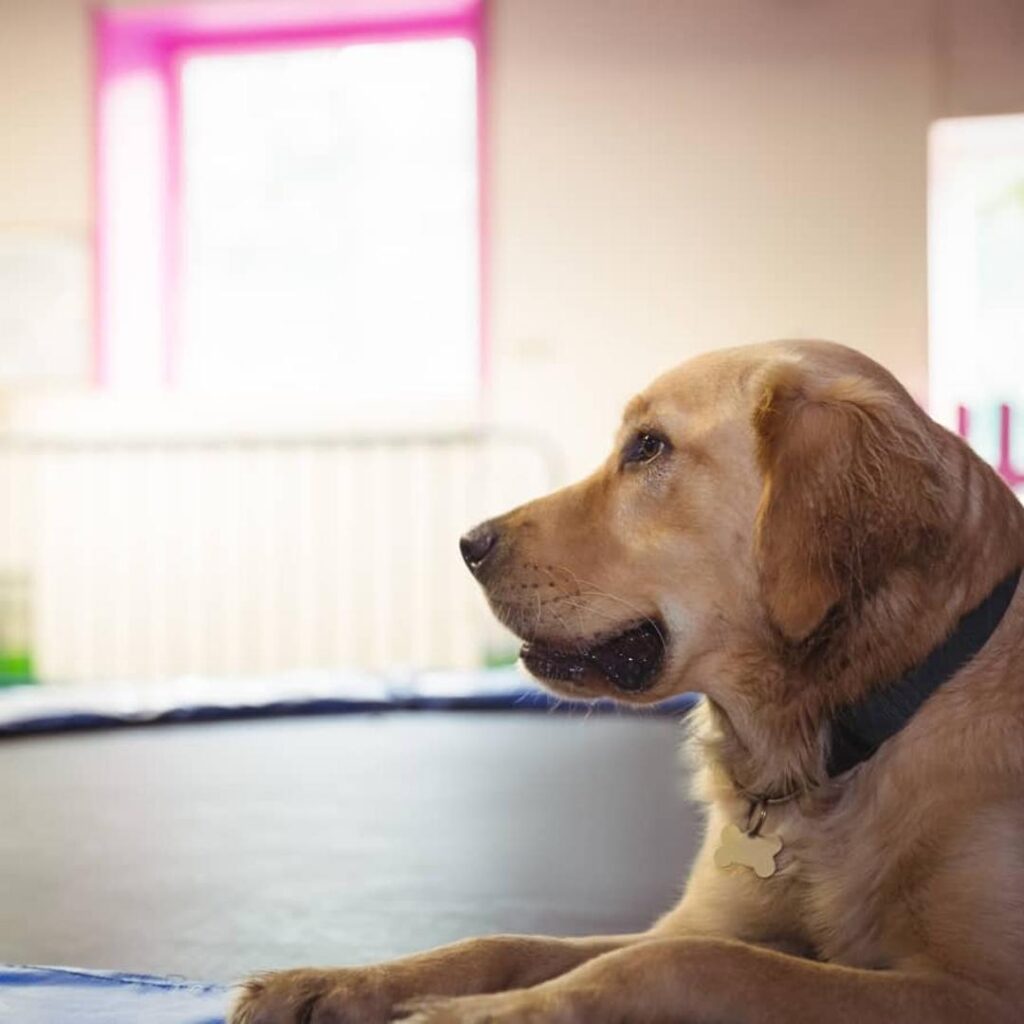
Trampoline bring immense joy and a touch of adventure to family gardens, drawing everyone outdoors for fun and exercise. The sounds of laughter and excitement that fill the air with each bounce underscore the happiness trampolines can spark among both kids and adults, creating cherished moments of togetherness and active play.
Yet, as we revel in the fun, the safety of our loved ones, including our pets, takes priority. Trampolines are designed with people in mind, leaving our pets unaware of the hazards. It’s essential to safeguard all family members, furry ones too, by taking preventive measures around the trampoline area.
This guide aims to provide essential tips for pet-safe trampolining, from recognizing dangers to implementing protective practices. We’ll share insights on making your backyard a secure and joyful place for the entire family—pets included—ensuring that the fun remains uninterrupted by accidents.
Understanding the Risks
When integrating the excitement of a garden trampoline into family life, it’s crucial to recognize not just the joy it brings but also the potential dangers it poses, especially to our pets. While statistical data specifically focusing on pet injuries related to trampolines might be scarce, the anecdotal evidence from veterinarians and pet owners underscores the need for caution. Pets, much like humans, are susceptible to a variety of injuries in and around trampoline environments, including falls, entrapment, and being inadvertently struck by users.
- Falls and Jump-Related Injuries: Pets, curious by nature, might attempt to jump onto or off the trampoline, leading to falls that can result in sprains, fractures, or more severe injuries. Unlike humans, pets don’t understand the mechanics or risks of bouncing on a trampoline and can misjudge distances or land awkwardly, potentially harming themselves in the process.
- Entrapment and Suffocation Risks: The spaces between the springs and frame of the trampoline, as well as under the trampoline, pose significant entrapment hazards. Smaller pets, in particular, can find themselves stuck, leading to potential suffocation or panic-induced injuries as they struggle to free themselves.
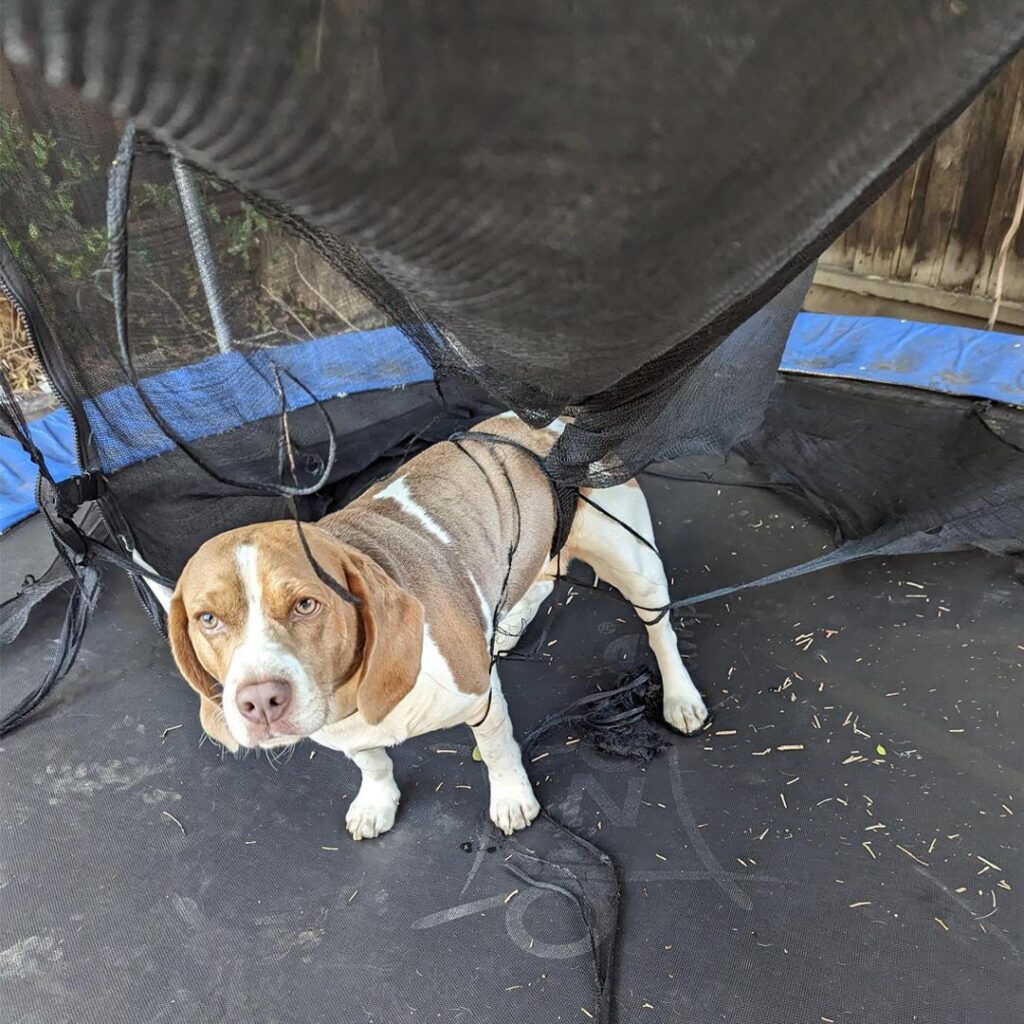
- Impact Injuries: Pets roaming near a trampoline run the risk of being struck by someone bouncing. This is especially concerning for smaller pets, who can be seriously injured if hit by a falling or bouncing child. The force exerted by a human coming down from a jump can be substantial, posing a real danger to pets below or beside the trampoline.
While direct statistics on trampoline-related pet injuries may not be widely available, the potential for harm is clear. Understanding these risks is the first step in creating a safer environment for our pets, ensuring they remain safe bystanders to our family’s trampoline fun rather than unintended victims
Preparing Your Trampoline Area
Ensuring the safety of family pets around bespoke trampoline starts with the initial setup and continues with regular maintenance. By carefully considering where and how the trampoline is placed and diligently keeping it in good repair, you can significantly reduce the risks to your pets.
Placement and Enclosure
Choosing a Pet-Safe Location: The location of the trampoline can greatly influence the safety of your pets. Place the trampoline away from pet play areas or frequented spots to naturally discourage their curiosity. Ideally, the trampoline should be set up on level ground to minimize the chance of the structure tipping or wobbling, which could intrigue or scare pets. Additionally, ensure there’s ample clearance around the trampoline, free from obstacles or hazards pets might run into if they get too close.
Utilizing Safety Nets and Pads: Safety nets are crucial, not just for human safety but for pets as well. They can serve as a visual and physical barrier, deterring pets from getting too close to the action. Ensure the netting is secure and free of gaps through which smaller pets could squeeze. Safety pads that cover the springs, hooks, and frame reduce the risk of entrapment and injury for pets that wander near the trampoline. These pads should be securely attached and checked regularly to ensure they remain in place and intact.
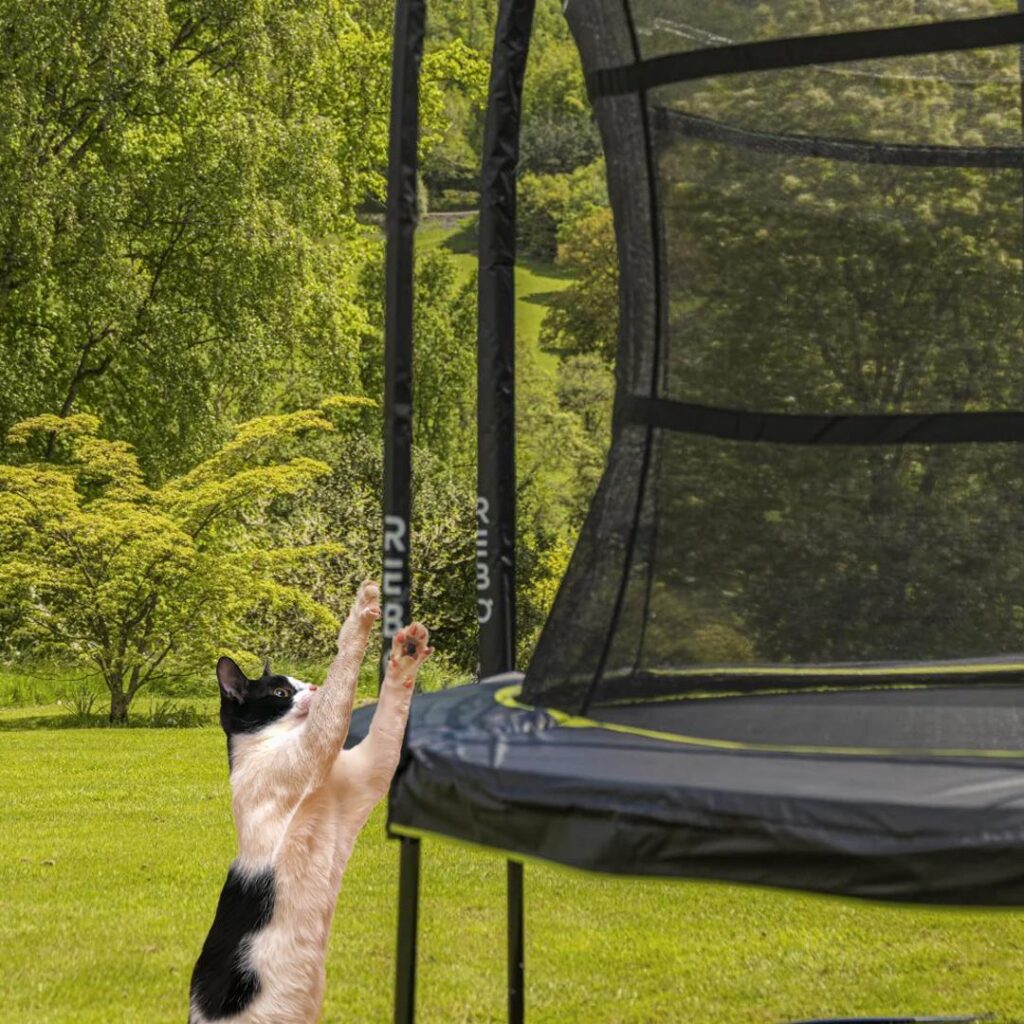
Trampoline Maintenance
Conducting Regular Checks for Wear and Tear: Routine inspections of the trampoline are vital to ensure its safety. Check for tears in the netting, exposed springs, or frayed pads that could entangle or harm a curious pet. The structure itself should be examined for stability—ensure all legs are firmly on the ground and that there are no rusted or weakened parts that could collapse.
Keeping the Area Clean and Free of Hazards: The space under and around the trampoline should be kept clear of debris, toys, and especially small, ingestible objects that could be tempting to pets. Regularly sweeping this area can prevent your pet from finding and swallowing something harmful. Additionally, consider placing a barrier or fencing around the trampoline if your pets are particularly persistent, to prevent access when it’s not in use.
Implementing these strategies for the placement, enclosure, and maintenance of your trampoline can create a safer environment for your pets. By taking proactive steps to minimize risks, you ensure that the trampoline area is a place of joy and fun for the entire family, including its four-legged members.
Training Your Pets
A critical component of pet safety around the fitness trampoline involves training and supervision. By teaching pets to respect boundaries and ensuring they are appropriately supervised, you can further reduce the risk of trampoline-related accidents.
Establishing Boundaries
- Teaching Safe Distances: Start by training your pets to understand that the trampoline area is off-limits. This can be achieved through consistent command training, such as “stay” or “away,” coupled with positive reinforcement. Use treats or their favorite toys as rewards when they obey commands to keep away from the trampoline. This method reinforces the idea that they can enjoy themselves and receive positive attention without needing to be near the trampoline.
- Implementing Physical Barriers: In some cases, verbal commands may not suffice, especially with highly curious or stubborn pets. Installing physical barriers, such as fencing around the trampoline, can provide a clear boundary. Ensure that these barriers are high enough to prevent pets from jumping over them and secure enough to prevent squeezing through gaps. For smaller pets, consider enclosing the bottom of the trampoline to prevent them from going underneath.
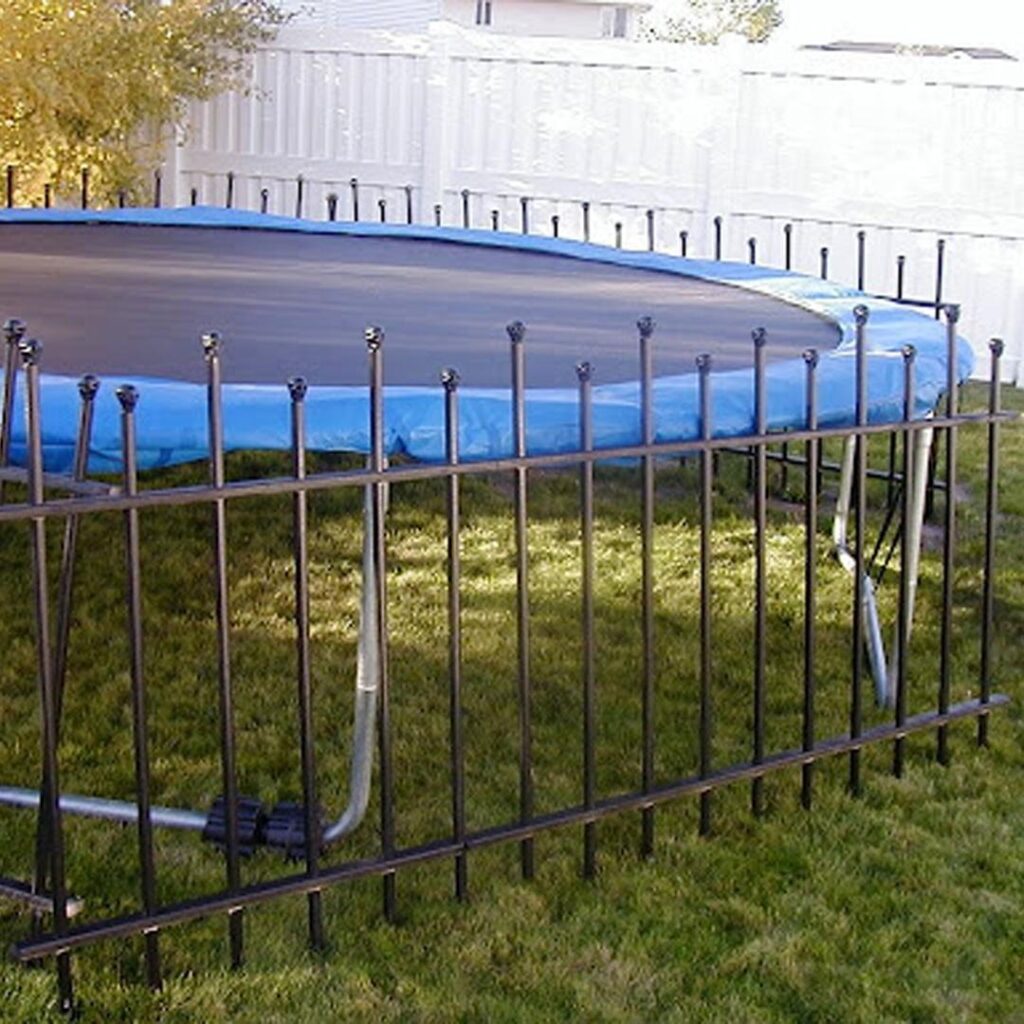
Supervision Strategies
- The Importance of Constant Supervision: Never leave pets unattended near an active trampoline. Pets can be unpredictable, and even well-trained animals might forget their training in a moment of excitement. Continuous supervision ensures that you can quickly intervene if your pet gets too close to the trampoline or shows signs of stress or agitation from the activity above.
- Engaging Pets Elsewhere: One effective strategy to keep pets safe is to engage them in alternative activities away from the trampoline. This could include playing with them in a different part of the yard, providing them with a new toy, or setting up a pet play area with their favorite items. For pets that are particularly drawn to the area when the trampoline is in use, consider having a family member or friend keep them company in a separate, enclosed space where they can’t hear or see the trampoline. This not only keeps them safe but also minimizes any stress or excitement caused by the bouncing.
By establishing clear boundaries and employing effective supervision strategies, you can enjoy the fun of your trampoline without compromising the safety of your beloved pets.
Safe Play Practices
Creating a safe environment for both children and pets near the In-ground trampoline involves establishing specific play practices and monitoring interactions. Educating children about the importance of pet safety and being vigilant about pets’ behavior can prevent accidents and ensure harmonious playtime for all.
Rules for Kids
- Teaching the Importance of Pet Safety: Children should understand that while pets are part of the family, they interact with their surroundings differently and can be at risk near trampolines. Educate children on the potential dangers trampolines pose to pets, such as injury from falling objects or the stress of too much noise and movement. Emphasize empathy and responsibility towards their furry siblings.
- Implementing a ‘No Pets on the Trampoline’ Rule: Make it a firm rule that pets are not allowed on the trampoline at any time, whether it’s in use or not. Explain to children that even if it seems like a fun idea to bounce with their pet, it’s incredibly unsafe and can lead to serious injuries for the pet. Consistently reinforce this rule and the reasons behind it to ensure children understand and respect the boundary.
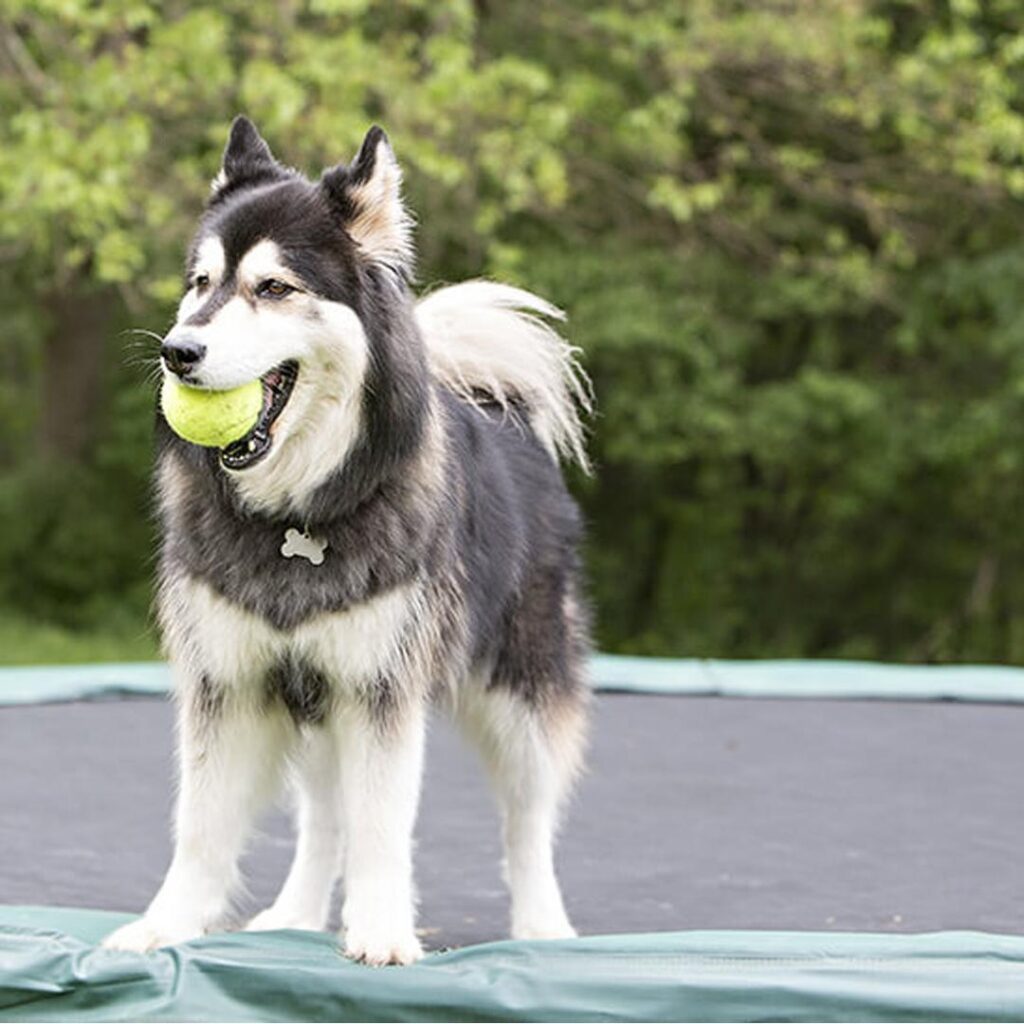
Monitoring Interactions
- Observing Pet Behavior: Keep a close eye on how pets behave around the trampoline, especially when it’s being used. Pets can become overly excited or stressed by the noise and movement, leading them to act unpredictably. Supervision isn’t just about preventing physical accidents; it’s also about ensuring pets feel secure and calm in their environment.
- Recognizing Signs of Stress or Anxiety: Familiarize yourself and your children with the signs of stress or anxiety in your pets. These can include excessive barking or whining, pacing, hiding, or showing signs of aggression. If you notice any of these behaviors, it may be necessary to remove the pet from the situation and provide them with a quiet, comfortable place away from the trampoline area.
Emergency Preparedness
Despite all precautions, accidents can still happen. Being prepared for an emergency can make a significant difference in the outcome of an unexpected injury to a pet near a trampoline. Knowing the steps to take and having the necessary resources at hand can help you act swiftly and effectively, minimizing the risk of further harm to your pet.
Immediate Steps Following an Injury:
- Remain Calm: Your pet will likely be scared or in pain, and your calm demeanor can help soothe them.
- Assess the Situation: Quickly assess your pet for visible injuries without moving them unnecessarily, as this could worsen their condition. Look for signs of pain, bleeding, limping, or distress.
- Contact Your Veterinarian: If you suspect your pet is injured, call your veterinarian immediately. Describe the situation and the symptoms. They can provide guidance on whether you should bring your pet in for an examination and the best way to transport them if needed.
- Follow Professional Advice: Depending on the injury, your vet may instruct you on how to care for your pet until you can get them to a veterinary clinic. This could include applying pressure to stop bleeding or gently immobilizing a suspected fracture with soft padding.
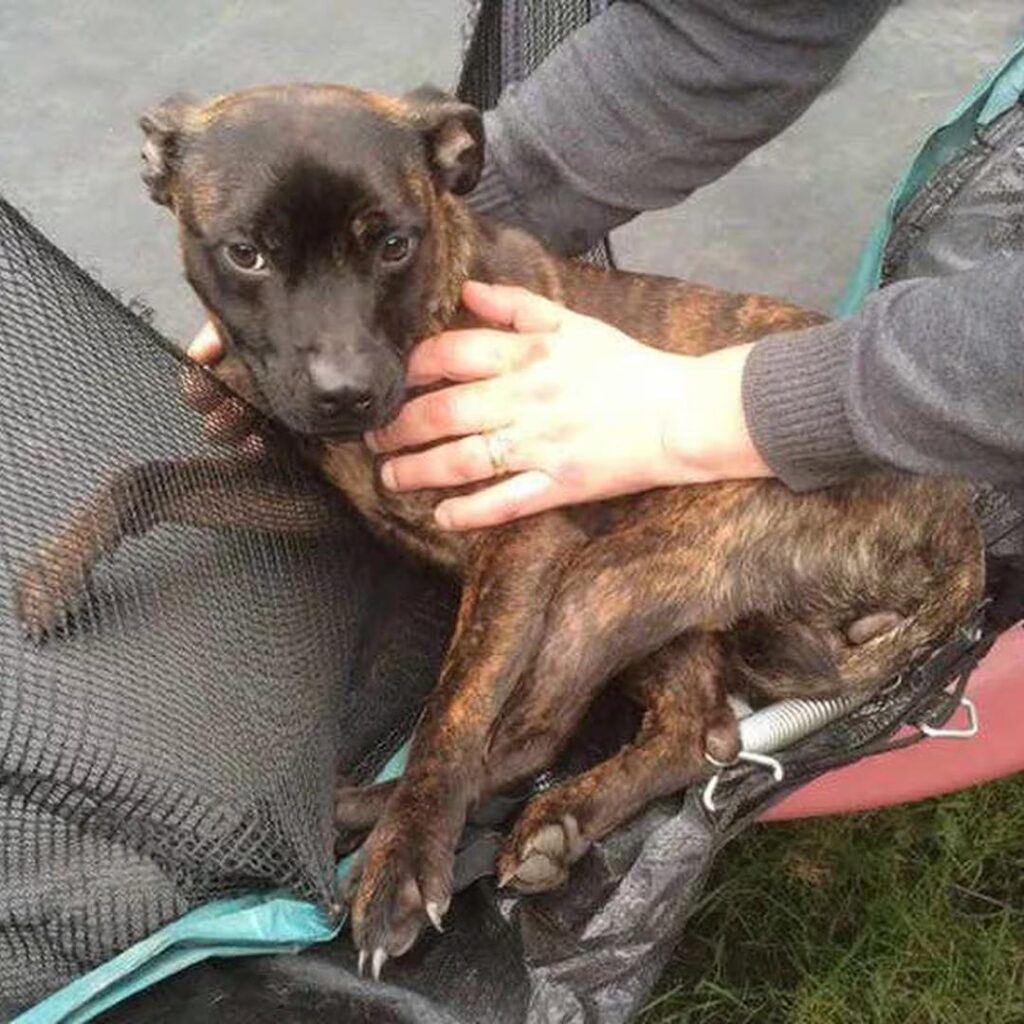
Preparing a Pet First Aid Kit:
Having a pet-specific first aid kit can be invaluable in an emergency. Your kit should include:
- A copy of your pet’s medical records and your veterinarian’s contact information.
- Gauze pads and rolls for wrapping wounds or muzzling an injured animal (only if necessary for safety).
- Tape for bandages (pets should not be bandaged with human adhesive bandages)
- To clean the area around injuries, use cotton balls or swabs.
- Hydrogen peroxide to induce vomiting if instructed by a veterinarian (never do this without consulting a vet first).
- Ice pack to reduce swelling.
- Disposable gloves for hygiene.
- Tweezers for removing splinters or ticks.
- A blanket for wrapping your pet if they are in shock or need to be carried.
Keeping Vet Contact Information Handy:
Ensure that your veterinarian’s contact information is easily accessible to all family members. It’s also wise to have the number for the nearest emergency veterinary clinic and the Animal Poison Control Center (if available in your region) on hand. Consider storing these numbers in your phone and posting them in a prominent place in your home, such as on the refrigerator or near the family bulletin board.
Emergency preparedness is about expecting the unexpected and being equipped to handle it. While we all hope never to face a situation where our pets are injured, knowing what to do and having the tools and information readily available can make a critical difference in ensuring their safety and well-being.
Conclusion
Ensuring the safety of nearby trampolines is crucial for the peace of mind of the whole family. By understanding the risks, preparing the trampoline area, training pets, practicing safe play, and being prepared for emergencies, families can create a safe environment that everyone, including four-legged members, can enjoy. This family-centric approach to safety encourages responsibility, awareness, and care, making the backyard a haven of fun and security for all. Let’s commit to making pet safety a priority, ensuring that the joy of bouncing on a trampoline is shared safely and responsibly.


